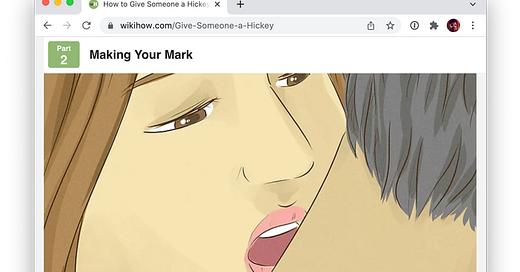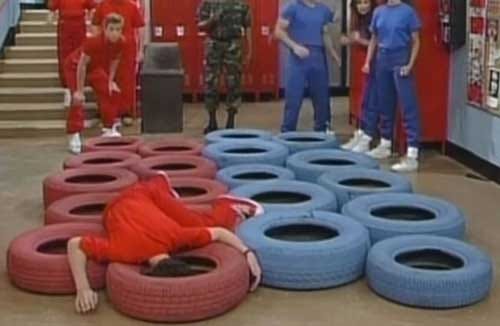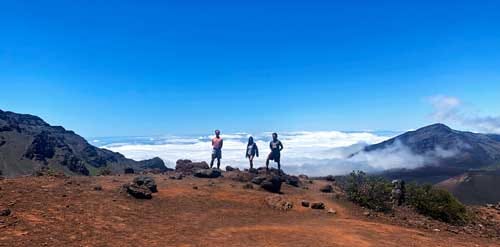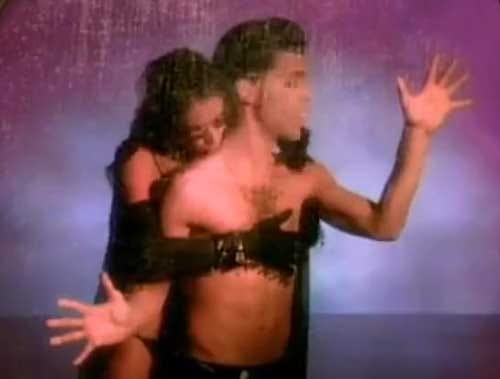Kiss and Say Goodbye
Between — New Years intentions, grunge, Dwayne Wayne, cool older cousins, ellipses, transformation, vampires, Jeff Goldblum, wind, pandemic love, Salman Toor, hickies.
1. Dress Different
When I was 11, I set a New Years intention to dress different. Around that time, I wore a lot of flannels. But the “grunge” look was pretty safe by 1995. You could buy it at the Gap.
Low-hanging jeans were a thing too, but mine were never that low. Not when the cool kids at my suburban Jewish day school wore khakis and nice sweaters. Plus, low-hanging jeans look funny with a kippah – those little dome hats the Jewish tribe wears. Unless you also wear the kippah low — dangling by the clip off the back of your head.
There was one fashion icon I looked up to, though: Dwayne Wayne from the show A Different World. Wayne’s style was playful and expressive, with pops of color, layers, and a dazzling array of cardigans. And then, of course, there was his signature flip-up sunglasses. He was geeky and preppy and sporty and creative and childish and smooth — sort of all at once.

I see a little Dwayne Wayne in old photos of the Filipino side of my family – the “Rosal clan,” we call ourselves. My older cousins had flair. My titas, too. I looked up to them.
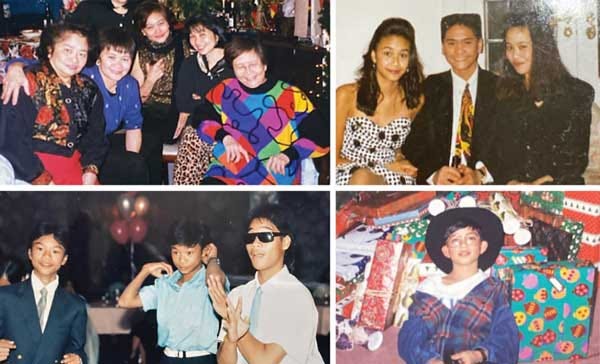
How I dressed at school never had the same flair. But then one day, while shopping with my mom for the holidays, I spotted a pair of flip-up sunglasses I could attach to my own glasses. She kindly bought them for me.
Every night before school in that first week of January, I laid out my flip-up sunnies, ready to don them for my ascent into the school bus. But every morning, I woke up with a drastically different fashion sense. I tried on my flip-up sunnies and thought, What am I doing? This isn’t me. As it turned out, my weary-eyed 6AM morning self was lame. He felt more like himself sans those sunnies — in his not-so-baggy jeans and his fake Gap flannel. He would look at this self in the mirror and say, “Now there’s someone I can count on.” Boo. What happened between the time I went to bed and awoke that took my cool?
And so it was that at the tender age of 11, I learned how hard it is to commit to a New Years intention. It wasn’t just about getting myself to do a thing. It was about getting myself to be that person who does that thing. It was about embodying someone new… and letting go of someone familiar. That second part is tricky. For years, I have found myself tripping over those ellipses like they were tires in an obstacle course.
Why do I let myself stumble? And then, why do I just stay there, stuck in the middle, face-down in a tire?
2. Ellipses… of The Undead!
How do you decide to “embody someone new… and let go of someone familiar?”
Philosopher Barry Lam examines this exact question in a recent episode of the podcast Hi-Phi Nation. He uses the example of deciding whether or not to become a vampire (in order to, you know, finally be together with the vampire love of your life – like Bella Swan in the Twilight series). Advantage: true love, unchained! Disadvantage: craving the taste of fresh human blood. What would you do for love?

How about another vampire love story conundrum. In the song If We Were Vampires by Jason Isbell, a forlorn character bemoans his and his love’s mortality, because it means that “one day I’ll be gone, or one day you’ll be gone...” It tears him up inside, almost to the point of suicide. If only the two of them were vampires, he resolves.
If we were vampires and death was a joke
We’d go out on the sidewalk and smoke
And laugh at all the lovers and their plans
I wouldn’t feel the need to hold your hand
At this point, he starts to change his mind.
Maybe time running out is a gift
I’ll work hard ’til the end of my shift
And give you every second I can find
And hope it isn’t me who’s left behind
The singer resolves it is better to be mortal, after all. The fragility of love is what makes having it so precious. That is, until he worries about losing her, all over again. He is stuck in a loop that looks something like this:
Becoming a vampire is a double-edged stake, if you will. On the one fang, it could relieve our forlorn character from the suffering of constrained love. On the other fang, instead of taking away the constraint, it would take away the love. This is not a problem for his vampire self, who would be happy without love, “laughing at all the lovers and their plans.” Paradoxically, it is a problem for his current, non-vampire self — the one who would no longer be around to suffer that consequence, anyway.
In Barry Lam’s assessment, people cannot really be “rational” when making transformative life decisions, because “some of the really important decisions you make for yourself might not paradoxically involve you at all.”
If only, instead of humans with pushover intentions, we were computers with programmed objectives. Like the T-800 model from Terminator 2: Judgment Day. The T-800 (aka Mr. “I’ll Be Back” Schwarzenegger) had its objective to protect John Connor, the leader of the Human Resistance, and to prevent Skynet from building a future of human-killing machines. Over the course of the film, John and the T-800 develop a deep friendship, one that seems to turn the T-800 human. And yet, after the T-800 succeeds on its mission, it does what very few humans ever could: destroy itself in a boiling vat so that no part of it could be used to build Skynet in the future.

If we were computers, we could actually follow our dreams! Except that we wouldn’t have dreams, anymore.
So how do I decide to embody someone new… and let go of someone familiar?
I am not sure it always is a decision. Maybe it happens unintentionally. I manage to change while never climbing out of the middle. I carry within me spirits that are both alive and dead. They are… the undead! I might not be a full-fledged vampire, no – but there are vampires in my blood. And clowns to the left of me. And jokers to the right.
Here I am. Stuck in the middle. With you.
3. Between Two Waves
Good things can happen when you’re stuck in the middle with someone. I fell in love in the middle of the pandemic.
Well, almost.
It was the fall of 2020, in between New York’s first and second COVID waves. A surreal time, thinking back. New York was loosening up, even though we were months away from a vaccine. People dined and drank in the streets, but if it was too cold… also indoors. Friends saw each other… but also, no they didn’t. People started dating again in person… and over video. Have you ever had a dream that conflated two different time periods? Somehow, in the fall of 2020, New York was like that.
I had just returned to Brooklyn after spending the summer in isolation on a quiet island off the coast of South Carolina – in a house with my cousin and his partner. There, we remote-worked in the day, took bike rides in the late afternoon, spotted egrets and alligators and crabs, cooked dinners every night, watched a program or two, and played a game of cards before going to bed. I got accustomed to a very domestic lifestyle. I learned to love it.
For my return to New York, I sought a partner with whom I could bask in my newfound love of domesticity. We would share quiet walks, homemade dinners, and deep conversations. We met on an app. She was an artist. I’m going to call her Marie. My first date with Marie was to the Whitney to see Salman Toor’s first solo exhibit: “How Will I Know.” Marie was rapt by Toor’s use of a particular shade of green. It just so happened to be her favorite color. In fact, it was the exact color of her mask. As far as first impressions go, she was that shade of green to me.
In Roberta Smith’s New York Times review of the show, “A Painter at Home in Two Worlds,” Smith endows that green with “a magical otherworldly interiority, as if it’s a color seen only by our hero and his friends.” Over the next few weeks that fall of 2020, Marie endowed me with the otherworldly interiority that I sought. We escaped into discussions over poems and passages and art. With Marie, I felt at home between the two waves – the first one that we survived… and the next one that we didn’t know was coming.
And then, in early December of 2020, I decided to visit my sister Shana in Hawaii. It was a 50/50 call whether or not to go, but Shana had already bought me a toothbrush. It would only be for a few weeks, I thought. After a walk through Prospect Park together, I lent Marie my favorite scarf (soft and black with brown Aztec patterns on the ends), so that she would know I was serious about coming back. I never did come back, of course. The second wave of the pandemic hit. I would be living on an air mattress in my sister’s living room in Honolulu for months. Had I stayed in New York, maybe Marie and I would have taken a chance and quarantined together. Maybe we would have fallen in love. Game, set, marriage. We would have been one of those pandemic romance stories they write about in the “Style” section of The New York Times. Instead, we fell out of touch.
My intention to have a tranquil domestic life alongside a lovely partner almost came true with Marie. And then… my trip to Hawaii unintentionally undid all that. And so, I’ve asked myself: would I have made the decision to visit Hawaii, knowing what I know now? The answer is clear. Absolutely yes.
In Hawaii, I built a new friendship with Shana, my ohana, and found a community of wonderful friends. I developed a deep and ever growing appreciation of Hawaii’s land and people. Being there, I no longer wanted to submerge into a magical otherworldly interiority. I wanted to emerge – physically and spiritually – into the great outdoors. I met people who took me to the mountains, I dated women who taught me how to surf, I found new instructors in yoga and dance, and I picked up a side-job at an Italian pasta truck on the beach in Waikiki.
If I could choose all over again, I would choose the unintended path. Not that I am being at all rational about this. As with the vampire conundrum, the choice is not a rational one. Hawaii changed me. I value different things. I am not the same person I was between the waves.
4. Life, uh, finds a way…
… to get in your way. By, uh, changing you.
A couple friends of mine posted a poem on Instagram this past New Years. I am Running into a New Year by Lucille Clifton. It goes:
i am running into a new year
and the old years blow back
like a wind
that i catch in my hair
like strong fingers like
all my old promises and
it will be hard to let go
of what i said to myself
about myself
when i was sixteen and
twentysix and thirtysix
even thirtysix but
i am running into a new year
and i beg what i love and
i leave to forgive me
Here, the speaker wants to be true to who they are. But what is true to who they are is different from what is true to who they were. One must make room for the other. But both are a part of their identity. Neither wants to just, like, disappear.
What if we thought of our own stumbling not as an act of self-sabotage, but as an act of self-preservation — where two opposing sides in us are struggling to survive? One way or another, by embracing one self, we are stifling the other. Why would we hate ourselves for doing that? We should forgive ourselves for doing that. I leave to forgive me.
The poem made me think differently about another wind-themed passage I have been pondering recently. “May the wind be always at your back.” I use to think the adage was about hoping external forces go your way instead of get in the way. Now, I read it differently. I think it is about hoping external forces give you the little push you need when your own feet are dragging.
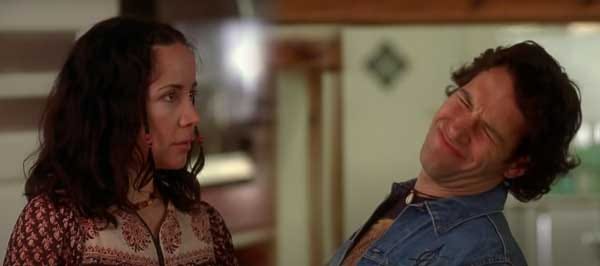
Many external forces don’t push us in the right direction, of course. Even if they do help us get out of our “ellipsical” state. I am thinking of another tale of monstrous transformation that I watched again just over the holidays: the 1986 film The Fly. Seth Brundle (played by Jeff Goldblum) is a scientist who builds a teleportation device. When he goes through it for the first time, a house fly goes in with him. The device has no protocol for teleporting two living beings at once. It successfully teleports him, but combines his molecular DNA with the fly’s, melding both into a single living being. The irony! Brundle successfully crosses the threshold, but when he arrives, he arrives as something else.
His brain is buzzing, his skin is corroding, his limbs are falling off. “That’s not too terrible, is it?” he half-jokes, adding with some insight: “Most people would give anything to be turned into something else.” What did Brundle turn into? “Am I becoming a 185 pound fly? No, I’m becoming something that never existed before. I’m becoming — Brundlefly. Don’t you think that’s worth a Nobel Prize or two?”
Maybe most people who “would give anything to turn into something else” do turn into something else. It’s just that it’s not what they expected. Maybe because it’s something that never existed before.
5. Unintended Kiss-equences
Just a few weeks after I left for Hawaii in December 2020, it was time to ring in the New Year of 2021. On New Year’s Eve at midnight, I sent Marie an audio excerpt of Italian theoretical physicist Carlo Rovelli explaining why the world is not made up of things. It is made up of kisses.
A stone is a thing because I can ask where the stone is tomorrow, while a happening is something that is limited in space and time. A kiss is not a thing, because I cannot ask, “Where is this kiss?” tomorrow. I mean, it’s just happened now. And I think that we [physicists] don’t understand the world as made by stones, by things. We understand the world made by kisses, or things like kisses – happenings.… A stone is just a common flickering of electrons which remains together not even forever … So to better understand the world … we should reduce it to happenings; and the happenings are always between different systems, always relations, or always like a kiss, which is something that happens between two persons. (On Being with Krista Tippett, March 2016)
My intention by sending this was to give Marie a New Years kiss of some kind, even though we were an ocean and several time zones apart. It was an attempt to keep this short-lived “thing” between us alive. I thought it was romantic.
But my midnight was not even her midnight, which made all the more apparent that what we shared was “limited in space and time.” This thing between us was flickering. And, caught in the middle of a very unstable world, we were flickering, too.
By summer, I decided I would leave my New York job and move to Hawaii. Marie never responded to my last text, in June. Later, I learned on Instagram that she moved to Brazil.
Do I miss her? Yes, a part of me misses her. But that part of me has let go. Truth be told, the rest of me still wants my Aztec scarf back.
And to think – that year after year, we set these New Year’s “intentions.” And to think – that feeling the way I do, I still set them. One reason I set intentions, I imagine, is it is a way for me to reset on a regular basis. It helps me reflect on how life has changed, take stock of what is working and what is not working, and consider what can be controlled and what cannot. But I believe there is another reason I set them. Maybe a reason why many of us do.
A kiss today may not be there tomorrow, no. But, well… something happened to me after the second wave, and I am embarrassed to share it, but it is kind of bizarre, and it is a strong-to-very-strong metaphor, so here is the story.
It was the spring of 2021. I was dating again – first one woman, and then another. Each of them just so happened to give me a hickey. They both apologized, but I found it beautifully absurd. I remember Shana noticing the first one. “Is that… what I think it is?” I felt like I was in high-school – that scene at the breakfast table where your parents look at you funny because you’re wearing a turtle-neck in the summertime. “Yes, Shana, it is,” I said, very matter-of-factly. And that’s it. That’s the end of the story. But there is a moral to the story, which is this: A kiss leaves the moment it’s over. A hickey leaves a mark.

How many of us sought to leave some kind of mark in the last two years, as the world tossed and turned? Some bought houses, some started their own businesses. People got dogs, got married, had babies. I like to imagine a spike in hickeys all across the world. Adults turned adolescent, desperate and passionate, like teenage vampires, sucking neck in backseats of cars — looking for something, anything, to stick. Something to help them get out of their “middle child” funk.
Maybe setting intentions is not about making a change, at all. Change happens to us 24/7. Maybe it’s a way of recording where we are at this very moment. Not an intent, but an indent. Like the middle-school kid carving their name into a desk. Growing up is weird, but “I was here,” in the middle of it all. I intend, therefore I am. For a flicker, at least.
Not into hickey metaphors? That’s understandable, and I thank you for staying with me for this long. How about that book on your shelf that you have never read, and likely never will? You acquired it to satisfy the interest of some precious part of you. Perhaps you keep that book on the shelf to keep that part of you around. Perhaps some day, like an archeologist of your own life, you will examine that book, this fossil from your past, to better understand what you have been through and who you are.
Or who knows! Perhaps some day, you will read that book. It can become relevant again. Not this year. Maybe the next? It’s possible. It happens.
In closing,


